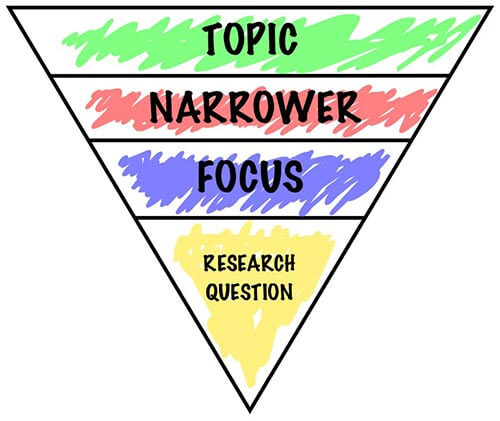Developing Your Research Question
Stephanie Ojeda Ponce
Starting with a Research Question
Searching for information can be overwhelming, but it doesn’t have to be! You’ll be introduced to specific information search techniques to make the information search process as smooth as possible. By generating a variety of ideas, stating some of your opinions, and developing research questions, you can focus your work to keep making progress on your research and writing projects.
By starting from a place of curiosity—as scholars, or students, or even in our everyday lives—we become more open to following where the research leads us. This is important! There is a remarkable difference between research papers written by students who have started with the conclusion and simply looked for evidence to back up their preconceived ideas vs. students who begin their research with a genuine curiosity to discover something and be changed in some way by the process. In this chapter, you’ll be guided through the process of how to narrow your topic and develop an open-ended research question.
After you narrow your topic and develop a research question, you need to find information sources that will support your claim, thesis, and argument(s) you’re making. This process involves searching for sources, reading or skimming the sources for relevancy, and deciding which ones to include in your paper. Reading and selecting a wide variety of literature will help you develop a solid research argument. For example, when you search for information to use in your paper, your search should also include perspectives that may not align perfectly with your claim – these alternative perspectives can help you think critically about the topic and help strengthen your claim, when you respond to the ideas in your writing.
Because of all their influence, you might worry that research questions are difficult to develop. Sometimes it can seem that way. But you’ll get the hang of it and, luckily, none of us has to come up with an incredible question right away. Remember, it’s a process! That’s why we talk about developing research questions instead of just writing them.
Steps for Developing a Research Question
The steps for developing a research question, listed below, can help you organize your thoughts.
Step 1: Pick a topic (or consider the one assigned to you).
Step 2: Write a narrower/smaller topic that is related to the first.
Step 3: List some potential questions that could logically be asked in relation to the narrow topic.
Step 4: Pick the question that you are most interested in.
Step 5: Revise the question you’re interested in so that it is more focused.

Practice
Once you know the steps and their order, only three skills are involved in developing a research question:
- Imagining narrower topics about a larger one,
- Thinking of questions that stem from a narrow topic, and
- Revising questions to be more specific or focused.
Every time you use these skills, it’s important to evaluate what you have produced—that’s just part of the process of turning rough drafts into more finished products.
Practice Activity Developing a Research Question
For each of the narrow topics below, think of a research question that is logically related to that topic. (Remember that good research questions often, but not always, start with “Why” or “How” because questions that begin that way usually require more analysis.) After you have written your question, click on the topic to see the questions we came up with.
Topics:
After you think of each research question, evaluate it by asking whether it:
| 1. Is not easily answered with a simple yes or a no (or a hasty google search) | It has some substance and requires explanation. |
| 2. Has an underlying problem with social significance (local, national or international) | It is important to someone other than just you! |
| 3. Poses a genuine question and aims for neutrality | It avoids using loaded language or suggesting a predetermined answer. |
| 4. Can be answered with reliable evidence | It is researchable. Others have already been contributing to this conversation. |
| 5. Has appropriate scope | It is not too narrow, nor too broad; it doesn’t leave you with too much or too little information. |
Sometimes the first draft of a research question is still too broad, which can make your search for sources more challenging. Refining your question to remove vagueness or to target a specific aspect of the topic can help.
Focusing Questions
The first draft research questions below are not focused enough. Read them and revise them to eliminate vagueness and increase focus. We’ve included some potential revisions, but yours might be even stronger!
First Drafts of Research Questions:
Adaptations
Material in this section has been adapted from:
Developing Your Research Question and Collecting Information with Research Questions from Writing Place: A Scholarly Writing Textbook by Lindsay Cuff. CC BY-NC-SA 4.0. 2023.
Developing Your Research Question in Choosing & Using Sources: A Guide to Academic Research by Teaching & Learning, Ohio State University Libraries, CC BY 4.0.



